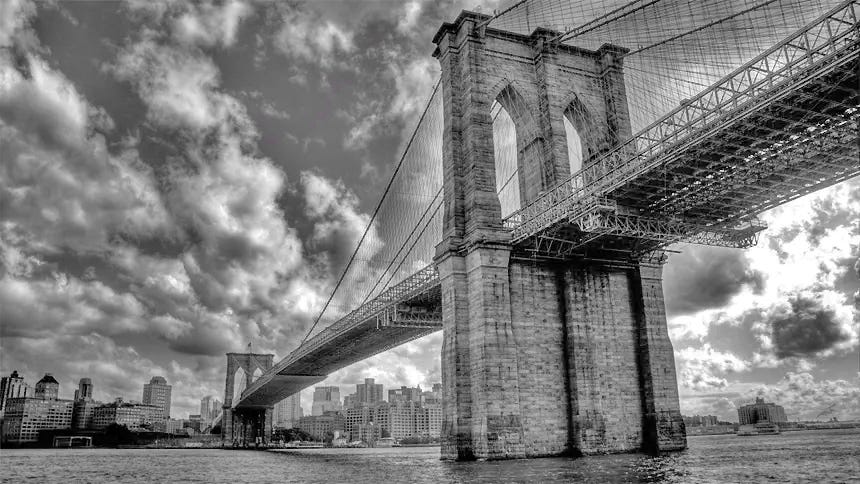The Brooklyn Bridge, conceived by John Roebling, is a combination of cable-stayed and suspension bridge technologies.
What John, Washington, and Emily Roebling Can Teach Us
[click to read]
After many long years of planning and building, along with numerous setbacks, the Brooklyn Bridge opened to traffic on May 24, 1883. The first vehicle to cross the bridge was Emily Roebling’s horse-drawn carriage. Emily carried with her a rooster in a cage symbolic of the victory realized that day. The victory was wrought from the darkness of the bridge’s deep underwater foundations, now realized in the vast structure that towered in the light traversing the river. As Emily gazed up at the bridge’s great gothic arches, which resembled the windows of a mighty cathedral, she reflected on her 11-year struggle, carrying a torch passed to her from her father-in-law, John Roebling, and her husband, Washington Roebling. Before the Brooklyn Bridge could come to symbolize a mighty American city, it had to begin with the vision of one man. (read more)
Some Early Articles for the Next Few Weeks
A friend of ours, headed to Mount Vernon, asked me “have you ever written anything about Mount Vernon?” She was subscribed to American Essence Magazine, but had done so so after the early issues, which did indeed feature articles about the Founding Fathers and Their Homes [click to read].
So, looking at a very busy Spring, I think it is a good idea to spend the next few weeks sharing those articles again, through links to the electronic edition. I sent our friend a few of these and sure enough, she was soon cheerfully sending photographs of her visit.
Mount Vernon, in particular, is a fascinating place you really must visit in person. That was my hope when I started writing these articles in 2021. I hoped we would visit our important historical places again, having been sequestered by lockdowns. It was time to reclaim our unique history again.
But there is so much more American story all around us. In the past three years I have explored Presidents’ houses, discovered stories of healing such as that of Robinson House at Lee Camp in Richmond. I’ve interviewed thought leaders like Joel Salatin of Polyface Farms and Charles Marohn of Strong Towns. They shared with me their visions of better ways of farming and reviving cities.
I’ve looked at the lives of great people of the past, such as George Westinghouse, whose railway devices saved countless lives. Tom Kelley, who developed the machine that allowed us to land on the moon, and James Edward Hanger, whose artificial leg gave back the lives of so many amputees.
I’m so blessed to be able to recount part of our amazing American story. I hope you will enjoy revisiting it with me in the weeks to come.



